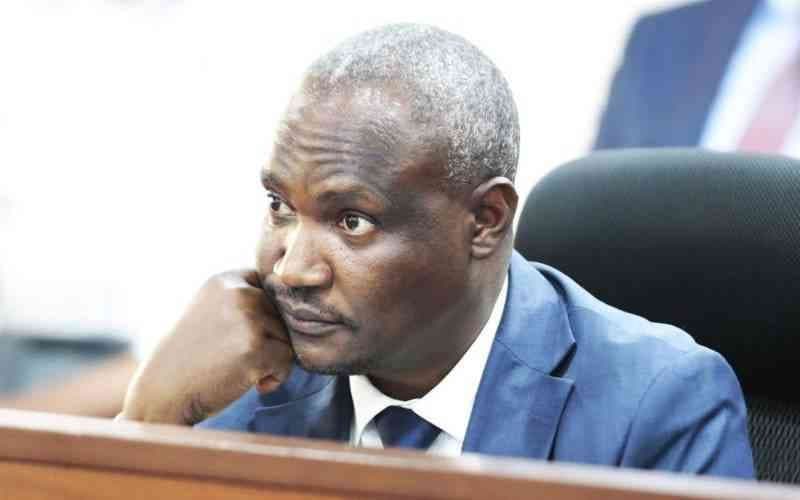Loading News Article...
We're loading the full news article for you. This includes the article content, images, author information, and related articles.
We're loading the full news article for you. This includes the article content, images, author information, and related articles.
A new report by Okoa Uchumi Kenya reveals that a significant portion of government revenue is allocated to debt servicing, raising concerns about fiscal sustainability and the impact on essential public services.

Nairobi, Kenya – Seven out of every ten shillings collected by the Kenyan government are now used to repay public debt, according to a recent report by the Okoa Uchumi Kenya initiative. This alarming statistic, released on Tuesday, October 7, 2025, highlights the country's deepening debt crisis and its potential implications for national development and citizen welfare.
The report indicates that Kenya's total public debt stands at Ksh 11.81 trillion as of June 2025, comprising Ksh 6.3 trillion in domestic debt and Ksh 5.48 trillion in external debt. This figure represents 67.8 percent of the country's Gross Domestic Product (GDP). The Treasury Cabinet Secretary, John Mbadi, acknowledged on Tuesday, October 7, 2025, that while this level is assessed as sustainable, it carries a heightened risk of distress.
Kenya's public debt has been on an upward trajectory for several years, driven by persistent fiscal deficits, significant infrastructure projects, and the implementation of a devolved system of governance. The debt-to-GDP ratio has steadily increased, reaching 70.8 percent in June 2023 from 50.0 percent in June 2010. The composition of debt has also shifted, with domestic borrowing now exceeding external loans. This shift is partly attributed to the government's increased inclination towards domestic financing amid lower interest rates and constrained access to external financing in 2024.
The Okoa Uchumi report criticizes gaps in public disclosure regarding Kenya's current debt standing, making full verification challenging. Transparency in debt management is a recurring concern, with calls for the government to disclose all loan details, including creditors and repayment terms. The initiative also advocates for the abolition of supplementary budgets, arguing that they widen the fiscal gap with unapproved expenditures.
Civil society organizations and human rights groups, under the Okoa Uchumi Campaign, have consistently raised concerns about the country's debt burden. Alexander Riithi, head of programmes at The Institute for Social Accountability (TISA), stated that domestic debt is more vulnerable to misuse and corruption compared to external debt, where funds can be more easily tracked. Saboti MP Caleb Amisi has urged Kenya to reduce its reliance on loans from institutions like the World Bank and International Monetary Fund, questioning their relevance to Africa's development.
The government spent Ksh 1.72 trillion on debt service payments during the 2024/2025 fiscal year, with Ksh 1.14 trillion going to domestic lenders and Ksh 579 billion to external creditors. Interest payments alone are projected to surpass Ksh 1 trillion in the 2025/2026 fiscal year. The debt service to revenue ratio reached 69.6% as of June 2024, significantly higher than the IMF threshold of 30.0%. This indicates a growing burden of debt servicing that continues to pressure the national budget.
The heavy allocation of revenue to debt repayment leaves limited funds for critical public services such as education, healthcare, and job creation. This can exacerbate inequality, concentrating wealth among elite lenders. The Okoa Uchumi report warns that without urgent reforms and transparent debt management, Kenya risks being trapped in a permanent cycle of borrowing and repayment, undermining essential services and hindering economic growth. High debt payments could also lead to increased taxes or stricter fiscal policies.
The Okoa Uchumi report highlights that Kenya's current debt standing cannot be fully verified due to gaps in public disclosure. This lack of transparency fuels concerns about accountability and the potential for misuse of funds, particularly with domestic borrowing. The proposed Finance Bill 2025 has also drawn criticism for potentially increasing the cost of living and weakening public services through regressive tax measures and cuts to essential programs.
The National Treasury aims to lower public debt to 55 percent of GDP by 2028 through fiscal consolidation, managing Eurobonds, slowing costly commercial loans, and pursuing debt-for-development swaps. The government also plans to diversify funding sources by issuing bonds in Asian and Middle Eastern markets and prioritizing concessional loans. Parliament is currently debating the proposed 2025/2026 national budget and the accompanying Finance Bill 2025, with civil society groups urging rejection of regressive proposals.
Observers will be closely watching the parliamentary debates on the Finance Bill 2025 and the 2025/2026 national budget for any revisions that address the concerns raised by civil society. The government's implementation of its Medium-Term Debt Management Strategy and its efforts to enhance transparency in debt reporting will be crucial in determining Kenya's fiscal trajectory. The impact of high debt servicing costs on the provision of essential public services and the overall cost of living for Kenyans will remain a key area of focus.